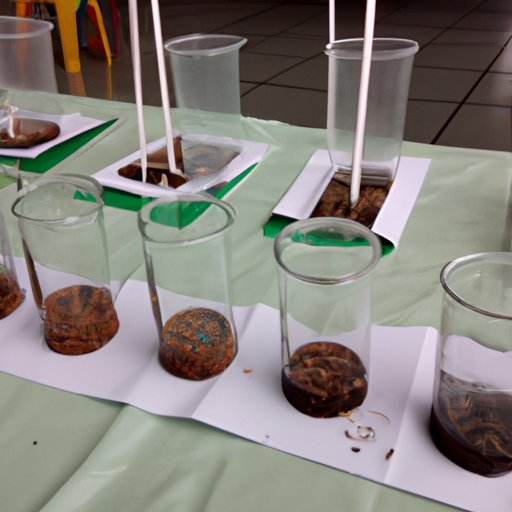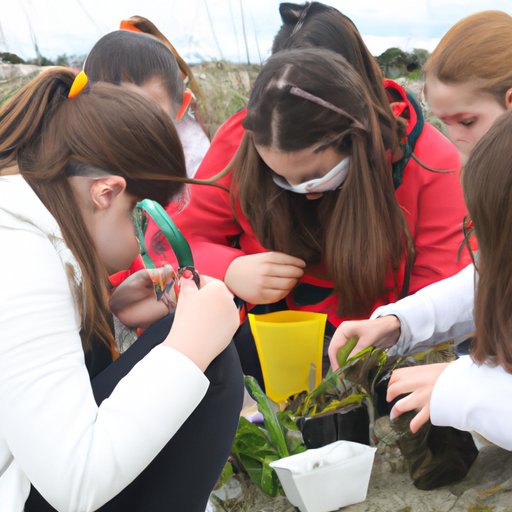Introduction
Soil erosion is a major environmental issue that can have serious consequences, such as reduced crop yields, water pollution, and land degradation. Fortunately, there are strategies that can be implemented to reduce soil erosion and one of these is the use of plants. This article will explore the science behind plant-based strategies to combat soil erosion and provide an outline for designing a simple science project to test the effectiveness of plants in reducing soil erosion.
Exploring the Science Behind Plant-Based Strategies to Combat Soil Erosion
Plants play an important role in preventing soil erosion by holding the soil in place with their roots, trapping sediment particles with their leaves, and providing ground cover. According to a study conducted by the University of Minnesota, “plants are effective in controlling both wind and water erosion because they reduce the velocity of flowing water, protect the soil from wind, and hold the soil in place with their roots.”
The effectiveness of plants in reducing soil erosion depends on a number of factors, including the type of plants used, the climate, and the amount of precipitation. For example, certain species of grasses are better at trapping sediment particles than other plants and some plants are better suited to dry climates while others thrive in wetter conditions. Additionally, the amount of precipitation can affect the effectiveness of plants in reducing soil erosion, as too much rainfall can cause the soil to become saturated, which can lead to increased runoff and more soil erosion.
Using plants to prevent soil erosion has numerous benefits. In addition to reducing soil erosion, it can help improve water quality by filtering pollutants, increase biodiversity by providing habitat for wildlife, and provide economic benefits by improving crop yields.

Designing a Simple Science Project to Test the Effectiveness of Plants in Reducing Soil Erosion
Designing a simple science project to test the effectiveness of plants in reducing soil erosion is a great way to learn about the science behind this process and make a difference in your community. Here are the steps for designing an experiment:
- Choose a location. Pick a spot in your area that has experienced soil erosion or is prone to it.
- Gather materials. You’ll need plants, soil, and other materials for your experiment.
- Set up the experiment. Create two plots in your chosen location—one with plants and one without—and observe the differences between the two.
- Take measurements. Measure the amount of soil loss in each plot over a period of time.
- Analyze the data. Compare the amount of soil loss in each plot and draw conclusions based on your findings.
When choosing plants for your experiment, consider the type of plants that will be most effective in preventing soil erosion in your area. For example, if you live in a dry climate, you may want to choose drought-tolerant plants such as cacti or succulents. If you live in a wet climate, you may want to choose plants that are well-adapted to wet conditions such as ferns or mosses.

Investigating Different Types of Plants and Their Ability to Prevent Soil Erosion
In addition to testing the effectiveness of plants in reducing soil erosion, you can also investigate different types of plants and their ability to prevent soil erosion. There are several ways that plants can be used to reduce soil erosion, such as planting trees to create windbreaks, adding vegetation to steep slopes, and establishing buffer strips along waterways. Each of these methods has its own benefits and drawbacks, so it’s important to consider the type of plants you are using, the climate, and the amount of precipitation when deciding which method to use.
It is also important to consider the impact of climate on plant growth. Different plants have different tolerance levels for different climatic conditions, so it is important to choose plants that are well-suited to the climate in your area. Additionally, the amount of precipitation can affect the growth rate of plants, so it is important to consider the amount of rainfall in your area when selecting plants.
Sharing Results and Findings with Others Through a Presentation or Report
Once you’ve completed your experiment and analyzed the data, you can share your results and findings with others through a presentation or report. Preparing a scientific report or presentation is a great way to communicate your findings to others and explore potential solutions for reducing soil erosion in your community. When preparing your presentation or report, be sure to include an introduction, a description of your experiment, your findings, and any recommendations for further research.
Conclusion
This article has explored the science behind using plants to prevent soil erosion and outlined the steps for designing a simple science project to test their effectiveness. It has examined different types of plants, the impact of climate on plant growth, and how to share results and findings with others through a scientific report or presentation. By conducting this experiment, you can gain a better understanding of the science behind soil erosion and contribute to the development of strategies for reducing soil erosion in your community.
(Note: Is this article not meeting your expectations? Do you have knowledge or insights to share? Unlock new opportunities and expand your reach by joining our authors team. Click Registration to join us and share your expertise with our readers.)
